Review Article
Iran, the Key Player of Transition
Head, National Iranian Gas Company, Iran
*Corresponding author: Hedayat Omidvar, Head, National Iranian Gas Company, Iran, Tel: +98-21-84875106, Fax: +98-21-84875040, E-mail: omidvar@nigc.ir
Received: December 12, 2018 Accepted: February 20, 2019 Published: February 26, 2019
Citation: Omidvar H. Iran, the Key Player of Transition. Int J Petrochem Res. 2019; 3(1): 255-261. doi: 10.18689/ijpr-1000144
Copyright: © 2019 The Author(s). This work is licensed under a Creative Commons Attribution 4.0 International License, which permits unrestricted use, distribution, and reproduction in any medium, provided the original work is properly cited.
Introduction
Natural Gas, Beauty of Energy
Natural gas as one the most significant fossil fuels, is playing a crucial role in national energy mix in different countries. Nevertheless, its applications have not been limited to energy providing, and has been used widely as the feed stock in production of different varieties of petrochemicals. So that most of new Iranian petrochemical complexes are designed and constructed based on natural gas feed.
Natural gas was firstly produced as one of the byproducts of crude oil and mostly was burned. Gradually along with increasing volumes of extracted natural gas, planning on gathering and using associated gas resulted in more usage of natural gas in different sectors including petrochemical feed and fuel. Following the developments, National Iranian Gas Company (NIGC) was established in 1965 as one of the subsidiaries of the petroleum ministry with initial capital of 25 million Rials [1].
Since its establishment, NIGC has gradually achieved capabilities and managed to have access to various sources and facilities such as experts and efficient human resources equipped with scientific and theoretical vision and knowledge, tools, equipment, machinery and various advanced workshops for implementing its operations proportionate with the economic and social development trend of the country, so that it can independently accomplish all the related tasks complying with the valid international acceptable standards.
Today, NIGC as one of the 4 main subsidiaries of the petroleum ministry is supplying more than 75 percent of total energy in the country as well as the feed stock for tens of petrochemical and industrial complexes around the country. The company is also operating one of the biggest high pressure gas transmission and distribution networks of the world facilitating export, import, transit and swap of natural gas in the country. In the point of natural gas treatment and supply, the company has the first position in the Middle East and is considered as one of major gas companies around the world.
At the time being, the number of the NIGC permanent staff is more than19000 official staff and more than 19300 total staff [2].
A Glance at the NIGCʼs Administration and Organization
The National Iranian Gas Company is comprised of 8directorates as follows:
1. Natural Gas Production Coordination & Supervision Directorate
2. Financial Affairs
3. Corporate Planning
4. Research and Technology
5. Human Resource Development
6. Gas Distribution
7. Natural Gas Distribution Coordination and Supervision (Dispatching)
8. International Affairs
In addition to the mentioned directorates, there are thirteen departments which directly report to the managing director as follows: Public Relations, Legal Affairs, Inspection & Complaint Consideration Affairs, Internal Auditing, Security, Assembliesʼ Affairs, Executive Affairs of Violation Investigation, Technical Inspection, Health, Safety and Environment (HSE), Information and Communication Technology, Commercial Expertise Affairs, Recruitment Affairs, and Structural Engineering Affairs.
The National Iranian Gas Company is also comprised of 51 subsidiary companies that each of them is active in different fields of natural gas industry with independent directorates. These companies are as follows.
Provincial Gas Companies: Connecting People to Reliability
More than 75 percent of the nationʼs energy needs is being fueled by natural gas. At present, there are 31 provincial gas companies throughout the country which are responsible for gas delivery to household consumers in cities, villages, power plants, industries and commercial consumers.
Gas treatment Companies
Eight Gas processing companies act under the supervision of Natural Gas Production Coordination and Supervision Directorate. The directorate supervises and utilizes processing plants. It is projected that through implementation of the development projects by 2020, the number of the gas processing companies will increase and based on the existing plans, the total gas processing capacity of NIGC will amount to 1200 Million Cubic Meters (MMC) per day, provided that all processing development projects are realized by 2020 (Figure 1). The eight gas processing companies which work under the supervision of the directorate are as follows:
1,2. Bidboland I and Masjed Soleyman Gas processing companies with the nominal capacity of 28 MMC per day
2. Shahid Hasheminezhad Gas processing company with the capacity of 58MMC per day
3. Sarkhun & Qeshm Gas processing company with the capacity of 17 MMC per day
4. Parsian Gas processing company with the capacity of 84 MMC per day
5. Ilam Gas processing company with the capacity of 6.8 MMC per day
6. Fajr Jam gas processing company with the nominal capacity of 125 MMC per day
7. South Pars Gas Complex Company including 8processing plants with the capacity of 466 MMC per day
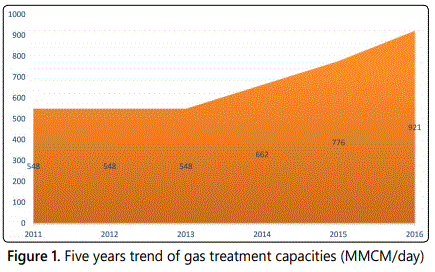
Iranian Gas Engineering and Development Company
Iranian Gas Engineering and Development Company is one of the subsidiaries of the NIGC. Based on the executive system of oil industry projects, the company is responsible for the implementation of National Iranian Gas Company master plans. In terms of the volume of under implementation projects, the company is the biggest one in the NIGC and invests most of the credits. The company is in charge of designing and construction of gas transmission pipelines, gas boosting stations, development of processing plants and infrastructure facilities (Figure 2).
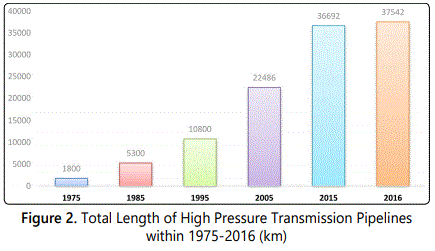
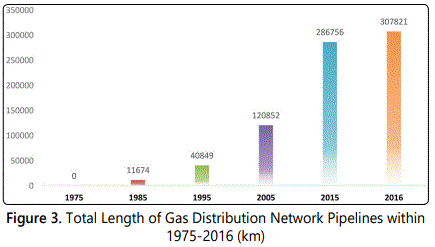
Iranian Gas Transmission Company
Iranian Gas Transmission Company is one of the other subsidiaries of NIGC. Since the establishment of NIGC in 1965, Gas Transmission Company was active under the supervision of Gas processing and Transmission Company. In 2005, the transmission directorate was organizationally separated from the processing sector and in 2006 the Gas Transmission Company was established. The most important task of the company is receiving natural gas, Ethane, LPG and gas liquids from domestic and foreign production sources and transferring it to domestic production terminals and export terminals.
The Iranian Gas Transmission Company is comprised of seven managerial districts and 10 operational zones. The company is responsible for operation management of about 36000 km gas pipelines all over the country (Figure 3). It is note worthy that the above-mentioned constructed pipelines which start from production resources to gas processing plants and continue up to the consumption points, are considered to be the main arteries of gas transfer through out the country. It is obvious that the complexity and sensitivity of the job cannot only be sensed through referring to some figures in this regard.
However, it is noteworthy that having assurance of about 700 MMC of natural gas transmission from the production regions to consumption points and export terminals could not be materialized without the efforts of more than 4000 hard working personnel and the management of 76 high pressure boosting stations, the existence of 257 compressors and administration of a modern telecommunication and telemetry network.
Underground Gas Storage: supporting Energy Security
Underground Gas Storage is one of the other major sections of the natural gas value chain aiming at building and maintaining balance between the natural gas production and consumption in special circumstances (sudden temperature drop). Activities include continuing the current projects and defining new projects. NIGC started momentum for surveying and studying in various parts of the country to identify potential underground structures suitable for gas storage; and studied 217 reservoirs. At present, Shoorijeh and Sarajeh underground gas storage reservoirs with an annual capacity of 4 BCM are operational and the Yortsha, Nasr Abad, Imam Hasan, Ghezel Tapeh, Baba Ghir and Bankoul reservoirs are under different phases of study and implementation. For the time being, Activities and projects of underground gas storage are being supervised by NIGEDC.
Iranian Gas Distribution Company
In line with the implementation of Article 44 of the Iranian Constitution and line 7 of the National Iranian Gas Company subsidiaries entrusting agenda, a company named Iranian Gas Distribution Company including 31 provincial gas companies was founded responsible for the following activities.
1) Reception, distribution, transaction and commission of natural gas regarding the related rules
2) Maintenance and administration of the operations related to the secondary lines, gas feeding and distribution networks, pressure-reducing stations, measurement stations, cathodic protection and other installations and building related to the company activities
3) Offering services to the natural gas applicants and subscribers, gas sale according to the contract and endeavor to promote the quality of before and after sale services to the customers
4) Devoting effort to establish the research system and strengthen the relationship with the scientific and research centers in order to reach the scientific and technological innovations and their implementation to answer the company needs
5) Transportation, warehouse keeping, marketing, distribution and selling of the products and services of other investment-receiving companies and individuals and legal persons who are active in the production and commerce fields
6) Offering technical, managerial, executive and financial services to the other investment-receiving companies
Iranian Gas Commerce Company
Iranian Gas Commerce Company as one of the other NIGC subsidiary companies was established in 2008 in line with the strategic objectives and policies to fulfill the following detailed tasks:
What We Are Looking For
The NIGC major objectives can be surveyed in two different sections: national and international. In both sectors, the main principle is customer satisfaction and maximum productivity achievement. In line with this and based on the outlook document (2020 horizon), the NIGC aims at ranking the third among natural gas producers in the world to achieve 8 to 10 percent of the global gas trade share. The second objective of the NIGC is ranking the first in the region in terms of gas technology.
Plans and policies of the NIGC in international level and ranking the third in the world and achieving a share of 10 percent of natural gas trade in the world are as follows:
1. Processing about 1200MCM per day of natural gas.
2. Enhancing natural gas share in the energy basket of the country by 70 percent, through substituting liquid oil products for natural gas.
3. Increasing natural gas export to regional and international markets through pipelines and other methods.
4. Attracting foreign investment through capital markets and/or joint projects.
5. Moving towards economic and commercial based vision and improving structures to maximize profitability and competition in international markets.
6. Maximization of the added value through using gas in energy consuming industries and establishment of industries like GTL and CNG.
7. Improving private sectorʼs position in downstream and gas distribution sections.
8. Cooperation with the neighboring countries in the region in production, transmission and diversification of gas trade opportunities.
9. Improving natural gas infrastructuresʼ management in the region.
10. Adjusting natural gas pricing system.
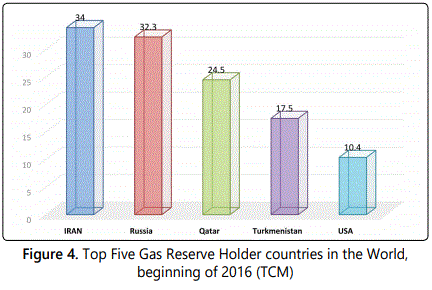
Iranʼs Ranking in the Worldʼs Gas Reserves
Gas reserves, like oil reserves, are categorized in three groups: proven reserves, probable reserves and possible reserves. The volume of the proved natural gas reserves has tripled over the last three decades. That is to say, the proven gas reserves from about 72 Trillion Cubic Meters (TCM) in 1970 has reached over 187 TCM at the beginning of 2016 and Iran with 34 TCM (18.2 percent of the total) of the world gas reserves ranks the first among the reservoir holders (Figure 4).
Among the operated gas reservoirs in Iran, two reservoirs namely Maroun Khami located in South east of Ahwaz and South Pars are of extreme importance. Especially, South Pars as the second and most important gas reservoir of Iran owns 50 percent of the countryʼs whole gas reserves and more than 8 percent of the worldʼs (Figure 5).
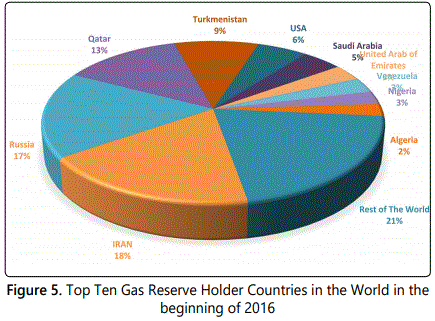
Growth: Our Core Business
According to the International Energy reference organizations, natural gas demand by 2035 will grow faster than other fossil fuels especially crude oil and coal (Figure 6). The demand growth is projected to be 1.6 percent per annum within the studyʼs period. In supply side, gas production from conventional resources will increase 0.7 percent per year, while the Middle East, Russia and Italy will be the mail suppliers of gas from conventional sources. In unconventional sector, shale gas comprises two thirds of increase in total natural gas production within the study period. After North America, as the main source of unconventional gas, china will be the second main supplier of the shale gas by 2035.
Industrial consumers shape the mail increase in natural gas demand within the projection years. The sector will comprise 45 percent of total demand growth by 2035. Power plants also will have a 36 percent of share in total growth of natural gas demand (Figure 7).
In demand side, china some Middle Eastern countries and the US will consist the main sources of consumption growth up to 2035. The main demand increase in china arises from growth in industrial and electricity generation demands. In the US, main growth in natural gas demand belongs to the electricity sector.
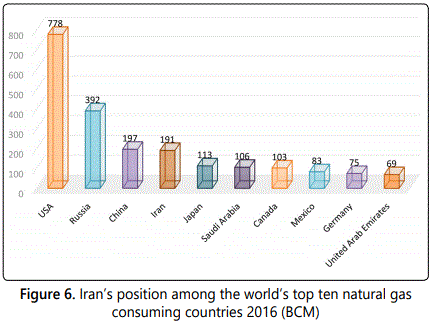

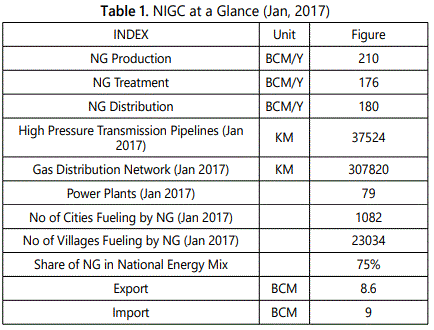
Heading for 1.2 BCM Record of production, Heading for Penetration into New Markets
It is the core strategy of the NIGC to enhance Iranʼs current share in the total global gas trade to reach 8-10 percent (Table 1). At present, processing and dehydration capacity of the Iranʼs gas processing plants is about 921 MCM per day; however, based on the Sixth Development Plan, it is to reach 1200 MCM per day within the first years of the plan (Figures 8, 9).
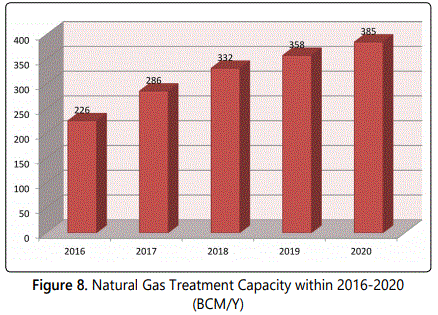
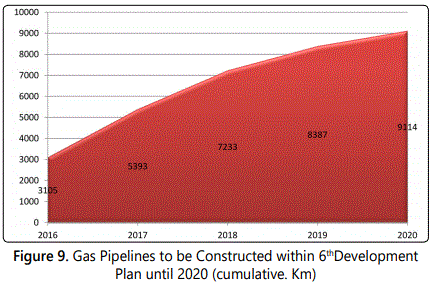
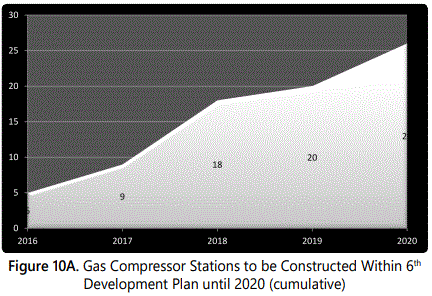
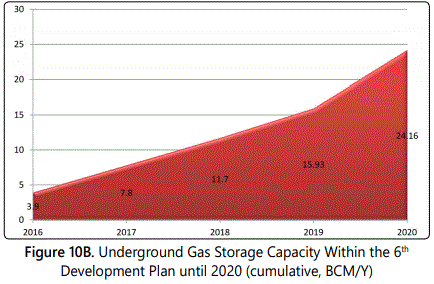
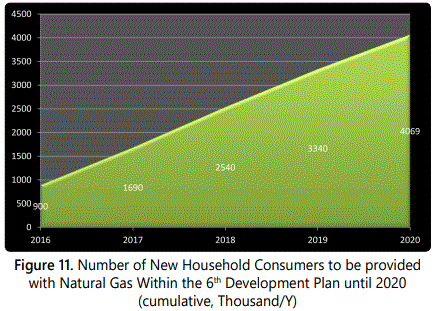
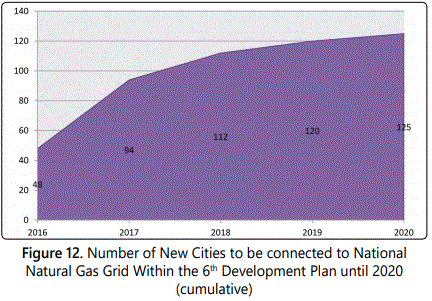
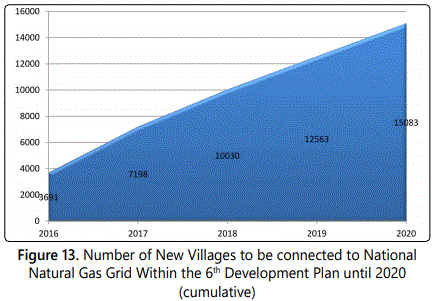
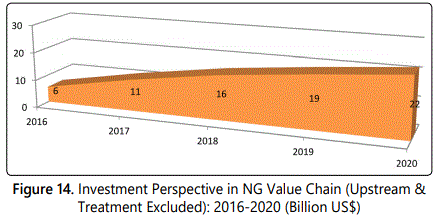
At present, Iranʼs figures 10A&B, 11 share in gas trade including export, import, swap, transit, and bartering gas for electricity is around 2 percent (Figure 12). However, Iranʼs share in natural gas global trade is to reach 10% by 2025 (Figures 13 and 14).
Iranʼs Natural Gas Opportunities, Privileges and Advantages: Regional and Global View
1. The shortest route to the main global markets.
2. Having the huge infrastructures for treatment and transmission of natural gas to domestic and foreign destinations.
3. The minimum required investment.
4. Possibility of natural gas transit to Turkey, the Europe and Persian Gulf region countries
5. Possibility of gas swap to the adjacent countries.
6. Existence of potential major consumers.
7. Owning 34 TCM proven gas reserves and ranking the first among big gas owners now and with the current trend by the next hundred years.
8. Ranking the third among producers that will rank the second in coming years.
9. Having necessary infrastructures for gas export and swap and transit to Europe, East Asia and Persian Gulf region countries (Figure 15).
10. The privilege of existing enough talented professionals and experts in all sections of gas operations including treatment, transmission, distribution, contracts and trading options (Table 2).

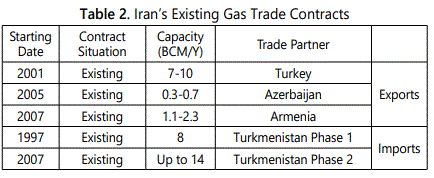
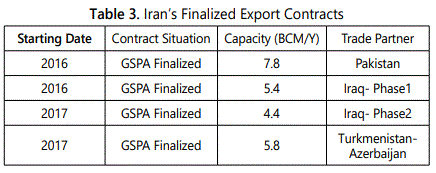

Growth: People Talking, Weʼre doing
Currently, the NIGC supplies about 75 percent of the countryʼs energy needs. The objective is having access to 1200 MCM per day of gas production, 70 thousand km of high pressure pipelines and achieving 8 to 10 percent of gas global trade in the next 15 years (Table 3). In line with the implementation of Article 44 of the Iranian Constitution, one of the priorities of the NIGC is privatization of the some sections of the value chain (Table 4). On this basis, it is supposed to increase the share of private sector in all the logistics, technical, maintenance and procurement services, power generators, pipelines and access roads. NIGC, relying on abilities of Iranian companies in engineering, procurement, manufacturing and construction of pipeline and compressor stations projects, will materialize its strategies in development of natural gas infrastructures to enhance gas supply to both domestic and foreign destinations and diversify gas trade options.
References